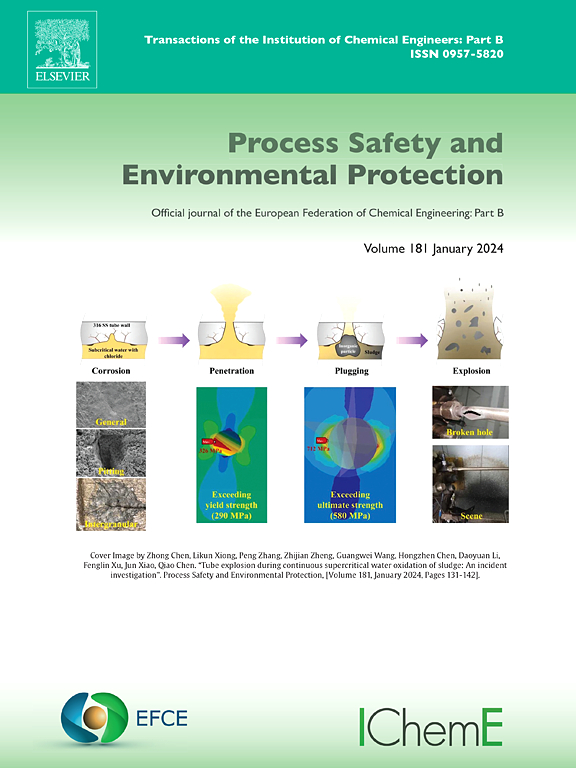Prediction of dioxins emissions from modern WtE plants with machine learning: in view of capacities, operation, and age of incinerators
IF 6.9
2区 环境科学与生态学
Q1 ENGINEERING, CHEMICAL
引用次数: 0
Abstract
As urbanization accelerates and consumption patterns shift, the global municipal solid waste (MSW) quantity continues to soar. In this context, incineration, a primary environmentally sound treatment method, has long been under the spotlight due to its associated dioxins emissions. Traditional methods for detecting dioxins are costly and cannot cover the entire operating time of the MSW incinerators, hence the growing interest in using machine learning to predict dioxins emissions. This study aims to predict dioxins emissions from waste-to-energy (WtE) plants using machine learning algorithms. In this study, we initially divided global data into three groups: China, Europe and the United States, and Japan. Then, we constructed prediction models based on deep forest regression and XGBoost regression, considering the age, capacity, and daily operation time of incinerators as influencing factors to forecast dioxins concentrations. The results indicate that age, capacity, and daily operation time are significantly correlated with dioxins emission concentrations (p < 0.01). Notably, the Japan-model performed the best, suggesting that age and daily operation time of incinerators significantly impact dioxins emissions. Furthermore, the study discovered that measures such as MSW classification, upgrades of air pollution control devices, optimized operating time, and constructing larger-scale WtE facilities can reduce dioxins concentrations. Moreover, we found that implementing any single one of these measures could lower dioxins concentrations by 20–50 %. This study offers a novel perspective for understanding and predicting dioxins emissions from WtE plants and provides a scientific foundation for the development and implementation of dioxins emission reduction policies.
利用机器学习预测现代垃圾焚烧发电厂的二恶英排放:考虑到焚化炉的容量、运行和使用年限
随着城市化进程的加快和消费模式的转变,全球城市固体废物的数量持续飙升。在这种背景下,焚烧作为一种主要的环境无害化处理方法,由于其相关的二恶英排放而长期受到关注。传统的二恶英检测方法成本高昂,且无法覆盖城市生活垃圾焚化炉的整个运行时间,因此使用机器学习来预测二恶英排放的兴趣日益浓厚。这项研究旨在利用机器学习算法预测废物发电(WtE)工厂的二恶英排放。在这项研究中,我们最初将全球数据分为三组:中国、欧美和日本。在此基础上,构建了基于深度森林回归和XGBoost回归的预测模型,将焚烧炉的年龄、容量和日运行时间作为二恶英浓度预测的影响因素。结果表明,年龄、容量、日运行时间与二恶英排放浓度显著相关(p <; 0.01)。值得注意的是,日本模式表现最好,这表明焚烧炉的使用年限和日运行时间对二恶英排放有显著影响。此外,研究发现,城市生活垃圾分类、空气污染控制设备升级、优化运行时间和建设更大规模的垃圾处理设施等措施可以降低二恶英浓度。此外,我们发现实施这些措施中的任何一项都可以将二恶英浓度降低20 - 50% %。本研究为认识和预测污水处理厂二恶英排放提供了新的视角,为制定和实施减排政策提供了科学依据。
本文章由计算机程序翻译,如有差异,请以英文原文为准。
求助全文
约1分钟内获得全文
求助全文
来源期刊

Process Safety and Environmental Protection
环境科学-工程:化工
CiteScore
11.40
自引率
15.40%
发文量
929
审稿时长
8.0 months
期刊介绍:
The Process Safety and Environmental Protection (PSEP) journal is a leading international publication that focuses on the publication of high-quality, original research papers in the field of engineering, specifically those related to the safety of industrial processes and environmental protection. The journal encourages submissions that present new developments in safety and environmental aspects, particularly those that show how research findings can be applied in process engineering design and practice.
PSEP is particularly interested in research that brings fresh perspectives to established engineering principles, identifies unsolved problems, or suggests directions for future research. The journal also values contributions that push the boundaries of traditional engineering and welcomes multidisciplinary papers.
PSEP's articles are abstracted and indexed by a range of databases and services, which helps to ensure that the journal's research is accessible and recognized in the academic and professional communities. These databases include ANTE, Chemical Abstracts, Chemical Hazards in Industry, Current Contents, Elsevier Engineering Information database, Pascal Francis, Web of Science, Scopus, Engineering Information Database EnCompass LIT (Elsevier), and INSPEC. This wide coverage facilitates the dissemination of the journal's content to a global audience interested in process safety and environmental engineering.
 求助内容:
求助内容: 应助结果提醒方式:
应助结果提醒方式:


